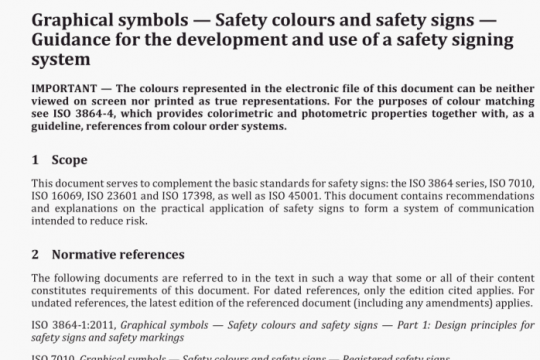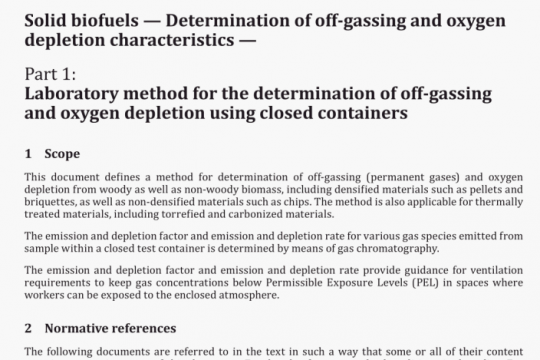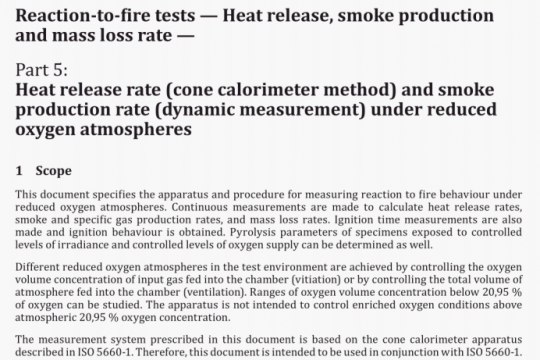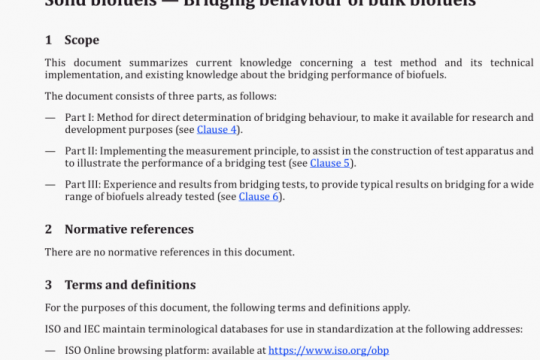ISO 23306 pdf free download
ISO 23306-2020 pdf free download.Specification of liquefied natural gas as a fuel for marine applications.
This document specifies the quality requirements for Liquefied Natural Gas (LNG) used as a fuel for marine applications. It defines the relevant parameters to measure as well as the required values and the test reference methods for all those parameters.
This document applies to LNG from any source, e.g. gas from conventional reservoirs, shale gas, coalbed methane, biomethane, synthetic methane. LNG described in this document can come from synthesis process out of fossil fuels or renewable sources.
This document identifies the required specifications for fuels delivered at the time and place of custody transfer (at the delivery point).
2 Normative references
The following documents are referred to in the text in such a way that some or all of their content constitutes requirements of this document. For dated references, only the edition cited applies. For undated references, the latest edition of the referenced document (including any amendments) applies.
Iso 6578, Refrigerated hydrocarbon liquids — Static measurement — Calculation procedure
Iso 6974 (all parts), Natural gas — Determination of composition and associated uncertainty by gas chromatography
ISO 6976, Natural gas — Calculation of calorific values, density, relative density and Wobbe indices from corn position
ISO 8943, Refrigerated light hydrocarbon fluids — Sampling of liquefied natural gas — Continuous and intermittent methods
EN 16726, Gas infrastructure — Quality of gas — Group H
3 Terms and definitions
For the purposes of this document, the following terms and definitions apply.
ISO and IEC maintain terminological databases for use in standardization at the following addresses:
— ISO Online browsing platform: available at https://www.io,org/obp
— I EC Electroped ia: available at http://www.electropedia.org/
3.1 biomethane
methane rich gas derived from biogas or from gasification of biomass by upgrading with the properties similar to natural gas
[SOURCE: ISO 14532:2014, 2.1.1.15]
3.2 liquefied natural gas LNG
natural gas that has been liquefied after processing
[SOURCE: ISO 14532:2014., 2.1.1.12, modified — Definition has been shortened, note to entry has been deleted.]
3.3 methane number MN
rating indicating the knocking characteristics of a fuel gas
Note 1 to entry: It is comparable to the octane number for petrol. One expression of the methane number is the volume percentage of methane In a methane-hydrogen mixture, that in a test engine under standard conditions has the same tendency to knock as the fuel gas to be examined.
[SOURCE: ISO 14532:20 14, 2.6.6. 11
3.4 natural gas
complex gaseous mixture of hydrocarbons, primarily methane, but generally includes ethane, propane and higher hydrocarbons, and some non-combustible gases such as nitrogen and carbon dioxide
Note 1 to entry: Natural gas can also contain components or contaminants such as sulfur compounds and/or other chemical species.
[SOURCE: ISO 14532:2014, 2.1.1.11
3.5 Wobbe Index
calorific value on a volumetric basis at specified reference conditions, divided by the square root of the relative density at the same specified metering reference conditions
[SOURCE: ISO 14532:20 14, 2.6.4.3, modified — Note to entry has been deleted.]
4 General requirements
4.1 The LNG at the delivery point shall conform with the characteristics and limits given in Table 1 when tested in accordance with the specified methods.
The components listed in Table 1 and Table 2 shall be measured to enable the calculation of the physical properties of the LNG at the delivery point.
4.2 The LNG delivered shall be free from any material at a concentration that causes the LNG to be unacceptable for use, i.e. material not at a concentration that is harmful to personnel, jeopardizes the safety of the ship. or adversely affects the performance of the machinery.
4.3 Pliysicochemical characteristics not requiring measurement are listed In Table 3.
It is not practical to require detailed chemical analysis for each delivery of fuels beyond the requirements listed in Table .1 or Table 2. Instead, a liquefaction plant, LNG terminal or any other supply facility, including supply barges and truck deliveries, shall have in place adequate quality assurance and management of change procedures to ensure that the resultant LNG is in conformance with the requirements of this document.
Examples of LNG compositions are given in Annex B.
Information on ageing of LNG can be found in Annexi and information on particles can he found in Annex E.ISO 23306 pdf download.




